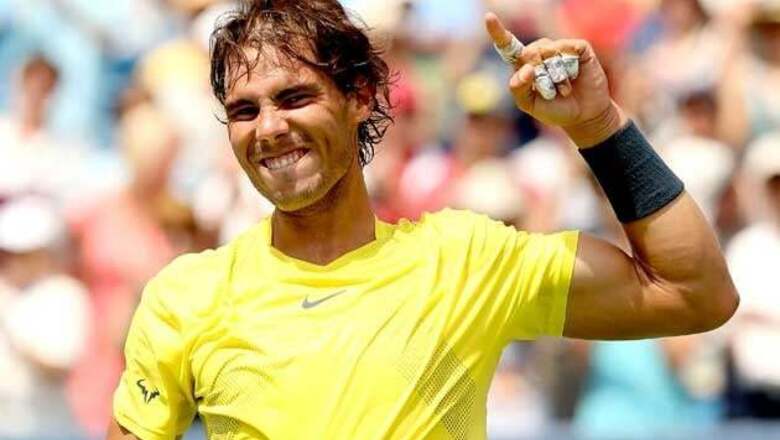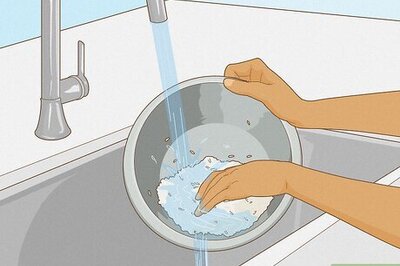
views
New York: Ask Rafael Nadal how his famously troublesome left knee is feeling on the eve of the US Open, and he'll balk a bit while formulating a response. "I am ..." the 12-time major title winner began, haltingly, during an interview with The Associated Press.
"You know ..." he resumed, before smiling sheepishly and pausing again. Eventually, Nadal offered something of a complicated answer. "I have to say that I am very well, because the results have been amazing since I came back," he said. "If I say something else, (it) will sound strange."
That's because when the year's last Grand Slam tournament begins on Monday, none of the players setting foot on the blue hard courts of Flushing Meadows possesses as much momentum - or is in as fine form - as the No. 2-seeded Nadal. He's won his past 10 matches heading into the first round against the 97th-ranked Ryan Harrison of the United States.
Another past US Open champion on Monday afternoon's schedule is 2000-01 winner Venus Williams, a former No. 1 now ranked 60th who will be taking on recent Wimbledon semifinalist and 12th-seeded Kirsten Flipkens of Belgium. At night, Williams' younger sister Serena, the defending champion, plays 2010 French Open winner Francesca Schiavone of Italy, while 17-time major champion Roger Federer faces 62nd-ranked Grega Zemlja of Slovenia.
The biggest curiosity when it comes to Nadal these days is how his knees will hold up. They've presented recurring problems for him over the years, particularly the left one, which kept him out of action from late June 2012 until February 2013. He missed the London Olympics, last year's U.S. Open and this year's Australian Open.
"I feel more comfortable now than six months ago, that's for sure," Nadal said, then quickly added: "But I still have pain some days."
He was asked whether he thinks that might be the case for the rest of his career.
"Hopefully not," the 27-year-old Nadal said. "Hopefully not." Hard courts could exacerbate the matter because of the pounding legs take on the unforgiving surface. Nadal himself maintains that there should be more tournaments played on other kinds of courts.
Yet he's been successful everywhere, winning the Australian Open and US Open once each, along with Wimbledon twice, to go along with his record eight championships on the slower red clay of the French Open. Nadal is 15-0 on hard courts in 2013, with his current run of victories built en route to titles at Montreal and Cincinnati.
"He's on a great streak right now. He's playing fantastic tennis. He's playing as well as anyone in the world right now," said the 21-year-old Harrison, who will be making his Arthur Ashe Stadium debut against the tournament's 2010 champion. "So I'm going to have to bring a really high level out."
Nadal's rivals at the top of the game have taken note, too, of course.
Summed up defending champion Andy Murray: "He's going to be very difficult to beat here."
Top-seeded Novak Djokovic, who won the 2011 US Open, said: "Nadal is definitely back, and he's playing maybe the best tennis that he ever has played on hard courts. ... He seems like he changed a little bit the game. He stepped in a little bit more. He knows that now he has to be a bit more aggressive than he usually is because of, I guess, his knees and everything and because hard court is not clay. It's not his favorite surface; it's faster. I'm sure he worked on that."
Nadal agreed with that assessment: He is making an effort to hit balls earlier than he used to. He is trying to be more aggressive.
"I'm clearly very impressed, especially seeing him play really well on the quicker hard courts. ... He's someone to be reckoned with. There were a lot of question marks when he came back. Especially, people thought he was just going to play on the clay courts, or most of it, and just some hard courts," said Federer, the champion in New York every year from 2004-08.
"He's playing a full schedule," Federer said, "and he's had an incredible season so far."
All told, Nadal is 53-3 with a tour-leading nine titles, more than twice as many as any other man. He reached the final at 11 of the 12 tournaments he entered. A year ago, when Murray beat Djokovic in five sets in the US Open final, Nadal was at home on the Spanish island of Mallorca, watching the tournament on television.
Nadal wasn't particularly concerned about missing this particular tour stop, he said, as much as he fretted about when - and, really, whether - he would get back to playing his best.
"I was worried about the recovery, not about being here," he said. "I was more worried about when I will have the chance to be back, how will the knee improve. ... Emotionally, there were ups and downs. It is hard when you are working every day and you don't see the improvement on the injury. That is the hardest moment, the toughest moment."
The last time he was seen in Grand Slam action, at Wimbledon in June, Nadal was being beaten by 135th-ranked Steve Darcis, the only first-round loss of his career at a major tournament. That also was Nadal's only defeat in his past 33 matches.
If he and Federer both win four times at the US Open, they will meet in the quarter-finals. They own a combined 29 Grand Slam titles, have faced each other 31 times (Nadal leads 21-10), including in eight major finals (Nadal leads 6-2) - and have never been on opposite sides of the net at Flushing Meadows.
"We deserved a final here in the US Open. Yeah, that is strange that it didn't happen. I remember Roger having match points in the 2010 semifinals, 2011 semifinals - so we were one point away. ... I missed it in 2009; I missed it in 2008," Nadal said. "Hopefully this time will be the good one."

















Comments
0 comment